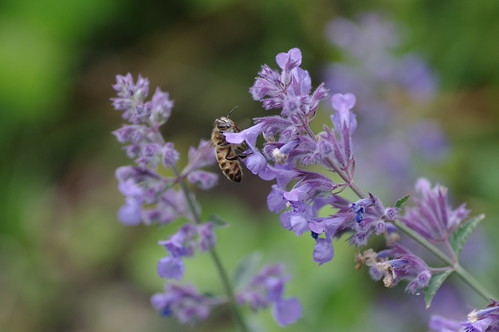1. There are 250 species of bumblebee worldwide.
 [b]Catmint[/b]
[b]Catmint[/b]
2. Estimates advise that the number of bumblebee species in lowland Britain have reduced in the middle of 50 and 70% since the 1950s.

3. Their family name is Bombus. One of my favourite Latin names is for the Great Yellow Bumblebee -Bombus distinguendus, closely followed by the Red-tailed Bumblebee - Bombus lapidarius.
4. The queen bee is the largest bumblebee followed by the female worker bee with the male (drone) bee being the smallest. Bumblebee workers can weigh in the middle of 0.04g and 0.60 g, whilst queens can weigh as much as 0.85g.
5. Depending on the species of bumblebee, worker bee's tongues can vary in size from 6mm to 12mm.
6. Bumblebees have four wings; the two rear wings are small and are ordinarily attached to the fore wings by a row of hooks called hamuli.
7. Bumblebees will pollinate flowers, fruit and vegetables in the garden, but furnish very small amounts of honey.
8. Bumblebees live in smaller groups than honey bees and do not tend to swarm.
9. Bumblebees will not die if they use their sting, whereas honey bees will. In fact drone bees do not have a sting.
10. A cuckoo bumblebee lays its eggs in another bumblebee's nest and leaves the workers of that nest to rear its young.
So how can we help to conserve bumblebees in our garden? They need to access pollen and nectar in flowers from March to September each year. What are the best flowers we can grow in our garden? Well, genuinely it is the customary bungalow organery flowers and native wildflowers. Bumblebees need to have access to a range of flowers that can adapt their different tongue lengths.
These flowers will also advantage honeybees and butterflies and many of the fruit trees will also furnish the added bonus of fruit in the summer and autumn too! In March and April apple, bluebell, cherry, heather, pear, plum, will advantage bumblebees. From May to August useful flowers comprise alliums, campanula, catmint, chives, cornflower, lavender, marjoram, mint, wallflower, red clover, honeysuckle, sage, and thyme, and a number of these herbs are an perfect accompaniment in cooking.
I have planted a number of herbs this year in a sensory bed, good for the senses in terms of what you see, touch, taste and smell and it is good to hear the bumblebees too!
10 Facts About Bumblebees
No comments:
Post a Comment